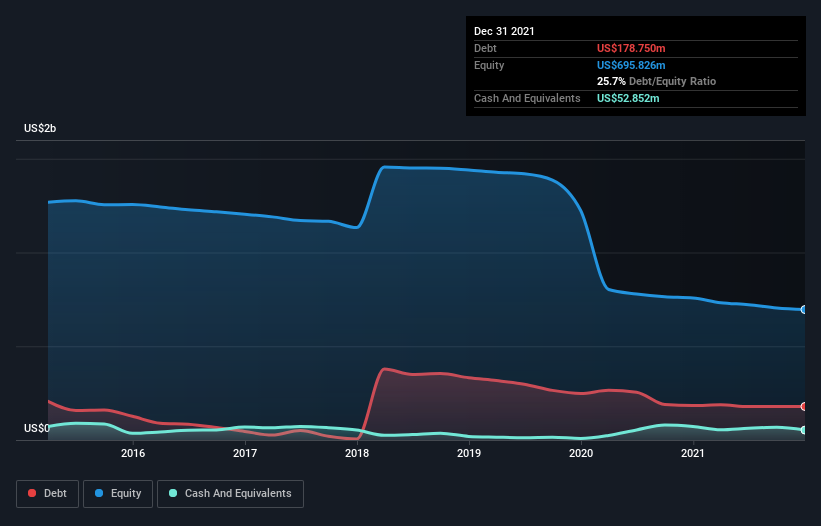- United States
- /
- Energy Services
- /
- NYSE:OIS
Oil States International (NYSE:OIS) Is Carrying A Fair Bit Of Debt
Legendary fund manager Li Lu (who Charlie Munger backed) once said, 'The biggest investment risk is not the volatility of prices, but whether you will suffer a permanent loss of capital.' It's only natural to consider a company's balance sheet when you examine how risky it is, since debt is often involved when a business collapses. Importantly, Oil States International, Inc. (NYSE:OIS) does carry debt. But the more important question is: how much risk is that debt creating?
What Risk Does Debt Bring?
Debt and other liabilities become risky for a business when it cannot easily fulfill those obligations, either with free cash flow or by raising capital at an attractive price. Ultimately, if the company can't fulfill its legal obligations to repay debt, shareholders could walk away with nothing. However, a more frequent (but still costly) occurrence is where a company must issue shares at bargain-basement prices, permanently diluting shareholders, just to shore up its balance sheet. Of course, the upside of debt is that it often represents cheap capital, especially when it replaces dilution in a company with the ability to reinvest at high rates of return. The first step when considering a company's debt levels is to consider its cash and debt together.
See our latest analysis for Oil States International
What Is Oil States International's Debt?
As you can see below, Oil States International had US$178.8m of debt, at December 2021, which is about the same as the year before. You can click the chart for greater detail. However, it also had US$52.9m in cash, and so its net debt is US$125.9m.

How Strong Is Oil States International's Balance Sheet?
Zooming in on the latest balance sheet data, we can see that Oil States International had liabilities of US$177.3m due within 12 months and liabilities of US$212.6m due beyond that. Offsetting this, it had US$52.9m in cash and US$186.1m in receivables that were due within 12 months. So its liabilities total US$151.0m more than the combination of its cash and short-term receivables.
This deficit isn't so bad because Oil States International is worth US$344.3m, and thus could probably raise enough capital to shore up its balance sheet, if the need arose. But we definitely want to keep our eyes open to indications that its debt is bringing too much risk. There's no doubt that we learn most about debt from the balance sheet. But ultimately the future profitability of the business will decide if Oil States International can strengthen its balance sheet over time. So if you want to see what the professionals think, you might find this free report on analyst profit forecasts to be interesting.
Over 12 months, Oil States International made a loss at the EBIT level, and saw its revenue drop to US$573m, which is a fall of 10%. We would much prefer see growth.
Caveat Emptor
Not only did Oil States International's revenue slip over the last twelve months, but it also produced negative earnings before interest and tax (EBIT). Indeed, it lost a very considerable US$57m at the EBIT level. When we look at that and recall the liabilities on its balance sheet, relative to cash, it seems unwise to us for the company to have any debt. Quite frankly we think the balance sheet is far from match-fit, although it could be improved with time. However, it doesn't help that it burned through US$10m of cash over the last year. So to be blunt we think it is risky. For riskier companies like Oil States International I always like to keep an eye on whether insiders are buying or selling. So click here if you want to find out for yourself.
If you're interested in investing in businesses that can grow profits without the burden of debt, then check out this free list of growing businesses that have net cash on the balance sheet.
New: AI Stock Screener & Alerts
Our new AI Stock Screener scans the market every day to uncover opportunities.
• Dividend Powerhouses (3%+ Yield)
• Undervalued Small Caps with Insider Buying
• High growth Tech and AI Companies
Or build your own from over 50 metrics.
Have feedback on this article? Concerned about the content? Get in touch with us directly. Alternatively, email editorial-team (at) simplywallst.com.
This article by Simply Wall St is general in nature. We provide commentary based on historical data and analyst forecasts only using an unbiased methodology and our articles are not intended to be financial advice. It does not constitute a recommendation to buy or sell any stock, and does not take account of your objectives, or your financial situation. We aim to bring you long-term focused analysis driven by fundamental data. Note that our analysis may not factor in the latest price-sensitive company announcements or qualitative material. Simply Wall St has no position in any stocks mentioned.
About NYSE:OIS
Oil States International
Through its subsidiaries, provides engineered capital equipment and consumable products for energy, industrial, and military sectors worldwide.
Excellent balance sheet with moderate growth potential.
Similar Companies
Market Insights
Community Narratives




